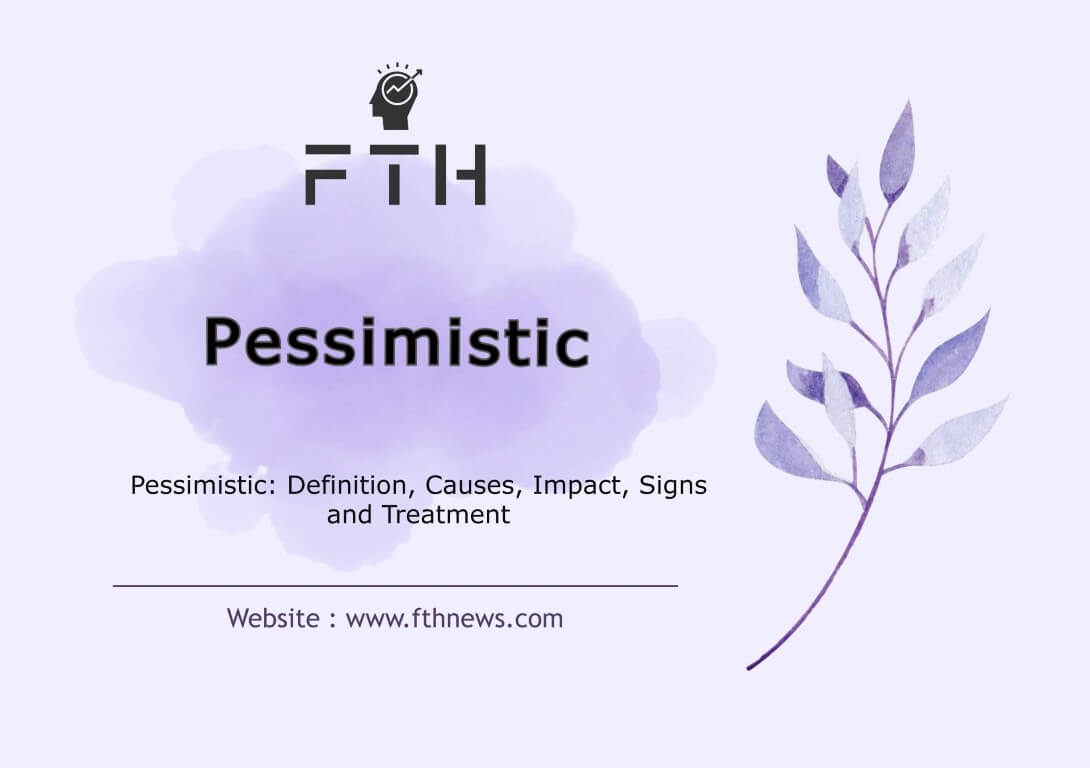
In a world where optimism is often championed, the concept of pessimistic thinking emerges as a formidable force that profoundly influences individuals’ lives. Pessimistic, characterized by the American Psychological Association as an attitude where one believes nothing is going well and achieving desires and goals is unlikely, can cast a dark cloud over one’s life if left unchecked. This blog post delves into the roots and consequences of pessimistic thinking, explores its causes, and offers practical insights on how to treat and overcome this challenging mindset.
Pessimistic Definition
“Pessimistic” is an adjective used to describe an attitude or outlook characterized by a general belief that things will go wrong or turn out poorly. A pessimistic individual tends to anticipate negative outcomes, focus on potential problems, and have a negative view of future events. This perspective often involves a lack of hope or optimism about the future and a tendency to see the darker side of situations. Pessimism is the opposite of optimism, where individuals expect positive outcomes and maintain a hopeful outlook on life.
For example:
- A pessimistic person might view a challenging situation as insurmountable and expect failure.
- Pessimistic thinking often involves dwelling on potential problems rather than anticipating positive outcomes.
- Someone with a pessimistic outlook may express doubt about their own abilities or the success of others.
It’s the opposite of optimism, where individuals tend to have a more positive and hopeful outlook, expecting favorable outcomes and focusing on the brighter side of circumstances.
The Causes of Pessimism: Unveiling the Roots
Pessimism is not a solitary state of mind; rather, it takes shape through a complex interplay of various factors. From personal encounters to genetic predispositions, the origins of pessimism are multifaceted. Let’s delve deeper into the key contributors to the formation of pessimistic attitudes:
1. Hanging out with Negative People:
Our social circles wield significant influence over our mental outlook. Pessimism often finds fertile ground in the constant companionship of negative influences. Regular exposure to individuals who consistently view the glass as half-empty can gradually shape one’s perception towards a more pessimistic stance.
2. Bitter Events and Failures:
Life is replete with challenges, disappointments, and setbacks. Unpleasant experiences and the failure to achieve desired goals can be pivotal triggers for adopting a pessimistic outlook. The accumulation of bitter events may foster a mindset that anticipates negative outcomes, hindering the ability to see potential silver linings.
3. Genetics and Hereditary Background:
Scientific studies suggest that there might be a genetic predisposition to pessimism. Certain individuals may inherit a disposition that makes them more susceptible to negative thinking. Understanding the genetic component of pessimism opens up avenues for exploring personalized approaches to fostering a more optimistic mindset.
4. Children’s Educational Style:
Early childhood experiences and educational methodologies play a crucial role in shaping an individual’s worldview. Environments that lack emphasis on positive reinforcement and fail to nurture an optimistic mindset may contribute to the development of pessimistic tendencies. Fostering positive learning experiences in childhood becomes imperative to cultivating a more optimistic outlook in adulthood.
5. Experiencing Persistent Negativity:
Consistent exposure to negativity, whether in the form of media, surroundings, or personal experiences, can significantly impact one’s perspective. A constant barrage of pessimistic messages can shape an individual’s worldview, making it essential to actively seek positive influences and counteract the pervasive impact of persistent negativity.
Understanding these causes provides valuable insights into the intricate web that forms pessimistic attitudes. By identifying and addressing these factors, individuals can take proactive steps toward cultivating a more positive and hopeful mindset, ultimately steering away from the clutches of undue pessimism.
The Impact of Pessimism: Unraveling the Consequences
A pessimistic mindset, if left unchecked, can cast a pervasive shadow over various facets of life. Let’s explore the profound consequences that arise from embracing pessimism:
1. Failure to Achieve Success:
Pessimism often acts as a deterrent to putting forth genuine effort. The belief that success is unattainable can lead to a reluctance to seize opportunities, resulting in unexplored potential and missed chances for personal and professional growth.
2. Mental Rumination and Conflict:
Negative thinking tends to breed excessive rumination, wherein the mind becomes entangled in a loop of self-destructive thoughts. This perpetual cycle of mental conflict can give rise to heightened anxiety, hindering one’s ability to focus on positive solutions and resolutions.
3. Disruption of Relationships:
Pessimistic individuals may find it challenging to establish and maintain meaningful connections. The constant anticipation of negative outcomes can create a barrier, leading to loneliness and strained relationships. Over time, the inability to form strong bonds may contribute to a sense of isolation.
4. Depression and Financial Problems:
Pessimism can be a catalyst for depressive states, casting a shadow over one’s emotional well-being. Additionally, financial challenges may arise as a result of hesitancy to pursue opportunities and confront challenges head-on. The reluctance to take calculated risks can limit financial growth and stability.
5. Health Consequences:
Prolonged pessimism has been linked to adverse health outcomes. Chronic stress, often associated with a negative mindset, can contribute to the development of various health issues, including cardiovascular diseases. The mind-body connection underscores the importance of maintaining a positive mental outlook for overall well-being.
6. Missed Opportunities for Growth:
The pessimistic lens often obscures the potential for personal and professional development. Individuals entrenched in negative thinking may fail to recognize opportunities for growth, innovation, and positive change, perpetuating a cycle of stagnation.
the consequences of pessimism extend far beyond mere thought, they shape the very fabric of one’s reality. Recognizing these impacts is the first step towards breaking free from the clutches of negativity. By fostering an optimistic mindset, individuals can unlock a world of possibilities, cultivate resilient relationships, and pave the way for a more fulfilling and vibrant life.
How to Identify Pessimism: Recognizing the Telltale Signs
Recognizing the signs of pessimism is the first step towards fostering positive change. Here are 15 clear indicators that someone may be grappling with a pessimistic mindset:
1. Constant Worrying:
Persistent negative thoughts about the future can manifest as an incessant worry. Pessimists often find themselves preoccupied with anticipating unfavorable outcomes, leading to heightened stress and anxiety.
2. Frequent Advice Giving:
Offering advice without self-reflection is a common trait of pessimistic individuals. This tendency can be perceived as judgmental, as the advice often lacks empathy or understanding of the complexities involved.
Improvement Tip: Encouraging self-reflection before providing advice allows for a more thoughtful and considerate approach, fostering better communication and understanding.
3. Excessive Secrecy:
Being overly private and guarded in social interactions may signal a reluctance to share personal information. Pessimists might fear vulnerability or judgment, leading to a hesitancy to open up to others.
Improvement Tip: Cultivating trust and gradually opening up to trusted individuals can create a supportive environment, breaking down barriers and fostering meaningful connections.
By recognizing these signs, individuals can embark on a journey of self-awareness and actively work towards replacing pessimistic tendencies with a more optimistic and constructive mindset.
4. Embracing Pessimism:
Accepting negativity as a life philosophy characterizes a person who has embraced pessimism. This outlook becomes ingrained, influencing how they interpret and respond to various life situations.
Improvement Tip: Shifting this mindset requires conscious effort and an openness to exploring positive perspectives. Encourage a gradual shift by acknowledging positive aspects in daily life.
5. Fixation on Negative News:
Being drawn to and consistently sharing negative news stories reflects a pessimistic inclination. Pessimists may unconsciously seek validation of their negative worldview through a focus on distressing current events.
Improvement Tip: Promoting awareness of the impact of media consumption can encourage a more balanced perspective. Actively seeking positive news or engaging in uplifting content can counteract the fixation on negativity.
6. Absorbing Criticism:
An inability to handle criticism, even when unrelated to oneself, is a common trait among pessimists. Criticism, whether constructive or not, may be internalized as a confirmation of their negative self-perception.
Improvement Tip: Cultivating resilience to criticism involves separating personal identity from feedback. Embrace constructive criticism as an opportunity for growth rather than viewing it through a negative lens.
Understanding and addressing these signs fosters self-awareness and provides a roadmap for individuals seeking to break free from the grip of pessimism. By actively working towards positive change, individuals can nurture a more optimistic perspective, leading to enhanced well-being and personal growth.
7. Complaining Habit:
A complaining habit, where an individual consistently expresses dissatisfaction and focuses on the negative aspects of every situation, signifies a pessimistic outlook. This perpetual negativity can impact personal relationships and hinder personal growth.
Improvement Tip: Encouraging gratitude practices can shift the focus from complaints to appreciation. Regularly acknowledging positive aspects in life promotes a more optimistic mindset.
8. Avoidance of New Experiences:
Pessimists often resist change and actively avoid new experiences, choosing to remain within their comfort zones. This fear of the unknown can limit personal and professional growth, hindering the exploration of new opportunities.
Improvement Tip: Gradual exposure to new experiences can build resilience and open the door to personal development. Embracing change fosters adaptability and a more positive outlook.
9. But… Sentences:
Ending positive statements with a negative twist, commonly seen in “but…” sentences, reflects a pessimistic tendency to undermine positive sentiments. This linguistic pattern often diminishes the impact of positive thoughts.
Improvement Tip: Adopting a conscious language shift involves replacing “but” with “and” to acknowledge both positive and negative aspects simultaneously. This nuanced approach promotes a more balanced perspective.
Understanding and addressing these signs provides individuals with the tools to actively combat pessimistic thinking. By fostering self-awareness and implementing positive changes, individuals can gradually reshape their mindset, fostering personal well-being and embracing a more optimistic outlook.
10. Failure to Achieve Goals:
The inability to attain desired success, often leading to feelings of inadequacy and jealousy towards others’ achievements, highlights a pessimistic mindset. Pessimists may struggle to channel their efforts constructively, impeding progress.
Improvement Tip: Setting realistic goals and celebrating small victories can break the cycle of pessimism. Emphasize the journey and personal growth rather than comparing oneself to others.
11. Energy Absorption:
Draining the positive energy of those around them characterizes pessimists who inadvertently impact the mood and enthusiasm of those in their social circles. This energy absorption can create a challenging environment for fostering positivity.
Improvement Tip: Practicing mindfulness and actively cultivating positive interactions can help dissipate negativity. Surrounding oneself with uplifting influences can contribute to a more optimistic atmosphere.
12. Lack of Excitement for the Future:
Diminished enthusiasm for planning and anticipating the future is a common sign of pessimism. Pessimists may view the future with trepidation, expecting negative outcomes, and subsequently, may lack the motivation to actively shape their destinies.
Improvement Tip: Engaging in goal-setting exercises and envisioning a positive future can reignite enthusiasm. Shifting the focus towards opportunities and potential positive outcomes promotes a forward-looking mindset.
Understanding and addressing these signs empowers individuals to take control of their mindset. By actively working towards positive changes and fostering a more optimistic outlook, individuals can break free from the limitations imposed by pessimism, paving the way for personal growth and a brighter future.
13. Inability to Appreciate Beauty:
Difficulty recognizing and appreciating the positive aspects of life is indicative of a pessimistic perspective. Pessimists may struggle to find joy in the beauty around them, focusing instead on perceived flaws or drawbacks.
Improvement Tip: Practicing mindfulness and cultivating a gratitude mindset can enhance the ability to appreciate the beauty in everyday life. Acknowledging small pleasures fosters a positive outlook.
14. Fear of Happiness:
The avoidance of happiness due to a fear of potential future disappointments is a common trait among pessimists. This fear can lead to self-sabotage, where individuals resist embracing joy for fear that it will be fleeting or followed by negative outcomes.
Improvement Tip: Confronting and challenging limiting beliefs about happiness can help break free from this cycle. Embracing positive moments without the shadow of anticipated disappointment encourages a healthier mindset.
15. Procrastination:
Constant delays and excuses for not taking action often accompany pessimistic thinking. Procrastination may stem from a fear of failure, leading individuals to avoid tasks and responsibilities.
Improvement Tip: Breaking tasks into smaller, manageable steps and setting realistic deadlines can combat procrastination. Addressing the underlying fear of failure enables a more proactive and positive approach to challenges.
Recognizing and actively working to change these signs empowers individuals to reshape their mindset. By fostering self-awareness and embracing a more optimistic perspective, individuals can break free from the constraints of pessimism, leading to enhanced well-being and a more fulfilling life.
How Treating Pessimism:
Overcoming pessimism is a transformative journey that requires conscious effort and self-reflection. Here are strategic approaches to treat pessimism and cultivate a more optimistic mindset:
1. Cultivate Optimistic Habits:
Actively seek out and focus on positive aspects of life. Train your mind to gravitate towards gratitude, even in challenging situations. By consciously embracing optimism, you can reshape your perspective over time.
2. Practice Mindfulness:
Develop awareness of negative thought patterns and work towards replacing them with positive ones. Mindfulness techniques, such as meditation and deep breathing, can help break the cycle of pessimistic thinking and promote a more balanced mindset.
3. Limit Exposure to Negative Influences:
Distance yourself from consistently negative individuals and environments. Surround yourself with supportive and uplifting influences that contribute to a positive atmosphere, encouraging personal growth.
4. Encourage Positive Communication:
Shift from complaints to expressing gratitude and positive thoughts. Engage in constructive conversations that highlight solutions rather than dwelling on problems. Positive communication fosters an optimistic outlook in both personal and professional relationships.
5. Set Realistic Goals:
Break down larger goals into achievable steps, fostering a sense of accomplishment. Setting realistic and attainable objectives creates a positive momentum, empowering you to overcome challenges with a proactive mindset.
6. Seek Professional Help:
If pessimism becomes overwhelming and begins to impact your daily life, consider consulting a mental health professional for guidance. They can provide personalized strategies and support to navigate challenges and promote positive mental well-being.
By implementing these strategies, individuals can gradually transform their mindset and break free from the clutches of pessimism. The journey towards a more optimistic outlook involves consistent practice, self-compassion, and a commitment to fostering positive habits for long-term personal growth.
Pessimism Benefits:
While drawbacks exist, there are instances where a measured level of pessimism can offer unexpected benefits:
1. Defensive Pessimism:
Defensive pessimism involves strategically using potential negative outcomes to increase motivation and self-esteem. This approach allows individuals to anticipate challenges and prepare for them, channeling anxiety into productive energy.
2. Pessimistic Realism:
Pessimistic realism embraces a balanced perspective on life, acknowledging both positive and negative aspects without undue optimism or pessimism. This mindset encourages informed decision-making and adaptability in the face of uncertainties.
Understanding the dual nature of pessimism enables individuals to navigate its drawbacks while recognizing the potential benefits in certain contexts. Striking a balance between caution and optimism is key to fostering resilience and personal growth.
Depression and Anxiety Relationship with Pessimism
1. Depression and Anxiety Cause Pessimism:
- The weight of persistent feelings associated with depression and anxiety, such as sadness, hopelessness, and constant worry, can mold an individual’s outlook toward pessimism. The emotional burden of these mental health conditions may shape a negative perspective, influencing expectations of unfavorable outcomes.
2. Pessimism Contributes to Depression and Anxiety:
- A consistently pessimistic mindset, marked by expecting the worst and dwelling on potential problems, can play a contributory role in the development or exacerbation of depression and anxiety. Anticipating difficulties and viewing situations negatively may heighten stress levels, fostering an environment conducive to these mental health challenges.
Recognizing the bidirectional nature of this relationship is crucial for a comprehensive understanding. Addressing both the cognitive aspects of pessimism and the underlying mental health conditions through therapeutic interventions can help break the cycle and pave the way for a more positive and balanced mindset.
Synonyms for “pessimism” include:
- Negativity
- Cynicism
- Despondency
- Dismay
- Gloom
- Hopelessness
- Melancholy
- Despair
- Defeatism
- Fatalism
These terms capture various aspects of a negative outlook or a lack of optimism about future outcomes. Each synonym may have slightly different nuances, but they all generally convey a sense of expecting unfavorable results or having a dim view of the future.
Conclusion:
Understanding the roots, consequences, and treatment of pessimism is essential for fostering a more positive and fulfilling life. By recognizing the signs, addressing the causes, and implementing proactive strategies, individuals can overcome the challenges associated with pessimism and embrace a more optimistic outlook. Balancing the realistic aspects of life with a hopeful perspective can lead to increased well-being and a more enjoyable journey through life’s ups and downs.
FAQ
A person with a negative outlook, expecting unfavorable outcomes.
Excessive pessimism can have a toxic impact on mental well-being and relationships.
A pessimist.
The Latin word “pessimus,” meaning worst.
Pessimism can be associated with various mental health conditions, including depression and anxiety.
Yes, with effort and mindset shifts, a pessimist can find happiness.
Pessimism itself is not a mental illness, but it can be a symptom of certain mental health conditions.
Changing thought patterns, practicing gratitude, and seeking positive perspectives can help shift pessimism.
Someone who combines self-centered tendencies with a consistently negative outlook.
Cognitive-behavioral therapy, positive affirmations, and mindfulness can help address and alleviate pessimistic tendencies.














